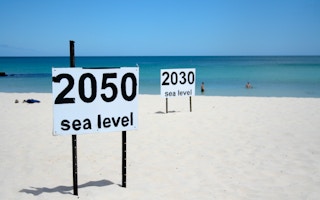The global climate is in unchartered territory. In the last 800,000 years, carbon dioxide concentrations have not been as high as they are now. The results are noticeable: nearly all hottest years on record have occurred after 2000 and the mean sea level is rising with about three millimetres per year.
Temperatures in most cities have risen even more rapidly than the global average due to the ongoing urbanisation, especially in Asia. More concrete and asphalt creates a hotter environment and this urban heat island effect could also cause an increase in rainfall over cities, making them more vulnerable places to live in.
However, determining the exact effect of climate change on cities is difficult. Scientists need very long periods of measurements and carry out detailed modelling studies, yet for many cities, these measurements are not available and climate models are generally too coarse.
Global climate models have a resolution of 150 to 300 kilometres, which averages out the urban climate changes, and makes it difficult to determine the impact of climate change and urbanisation versus natural variability.
Downscaling is a technique that can be used to make climate models more relevant for cities, though this requires very expensive supercomputers and highly trained experts – expenses that most cities cannot afford.
Even if cities embark on local climate modelling – such as city-state Singapore has done – model results have limitations. Aside from data availability and scientists’ partial understanding of climate and weather physics, model results are based on scenarios that incorporate several future unknowns. Modellers will need to make assumptions on things like how carbon fuels are going to be replaced by sustainable alternatives such as solar and wind power.
As a result of the uncertainties, climate projections have wide ranges. For instance, the climate projections for Singapore show that the mean temperature in the years 2070-2099 could be between 28.8 and 32.0°C, the average annual rainfall could range between a decrease of 12.4 per cent and an increase of 26.8 per cent. The mean sea level could rise between 0.25 and 0.76 metres. These are outcomes considered ‘plausible’ by the Centre for Climate Research Singapore, with the caveat that there is a possibility that specific aspects of future climate change could lie even outside these ranges.
“
Climate change projections play an important role in climate adaptation planning, design and awareness, but due to the inherent uncertainties in predicting the future the importance should not be overstated.
With so much uncertainty, what is the use of these climate projections? Policymakers and engineers want to have a single number to work with. Water engineers cannot efficiently and cost-effectively plan and design a reliable urban water supply system for Singapore if they need to take into account that the future February rainfall can decrease by 82.4 per cent or increase by 23.9 per cent. Money on backup desalination capacity would be wasted if rainfall would increase. Planning long-term drainage investments on an average scenario could result in more flash floods if heavy thunderstorms would increase. And coastal flood protection is expensive, especially if it is hardly used.
Still, there are several reasons why climate projections can be useful.
Firstly, it creates awareness for climate change adaptation and mitigation, especially as climate reports generate media interest. The main message of the projections is that the climate is changing, and long-term plans and investments need to take into account different climate conditions – be it positive or negative – in the future. Furthermore, it reinforces the message of environmental conservation and use of more sustainable sources of energy. Climate projections can also be used to raise public support for government investments in climate change.
What remains is the question on how policymakers and engineers need to plan and design for climate change when climate projections give at best some indication of the possible changes. One approach to this is, interestingly, accepting that uncertainty exists and developing flexible adaptation policies. The approach basically turns the reasoning around: instead of taking a ‘single number’ from a climate scenario and design for that scenario, policymakers should look at the current policies and engineers at existing infrastructure and determine when these no longer meet their objectives.
Alternative policies and infrastructure investments need to be planned for when this happens. This results in flexible adaptation pathways that have the flexibility to change strategy when required.
For example, dams of coastal freshwater reservoirs that cities such as Hong Kong and Singapore use for drinking water supply may need to be heightened as sea level rises. Using a flexible approach, it is determined what increase of the sea level triggers investments. At what point in the future that happens is less relevant.
The approach also calls for the adoption of step-wise, flexible approaches with no-regret decisions. This means that measures are put in place that are required and cost-effective now but are flexible enough to be adjusted in the future based on the climate information that is available at that time. This includes, for instance, reserving space for future expansion of drains when they are first constructed.
Climate change projections play an important role in climate adaptation planning, design and awareness, but due to the inherent uncertainties in predicting the future the importance should not be overstated. The government agencies should carefully develop flexible plans and designs to deal in an efficient and cost-effective way with climate change.
Joost Buurman is a Senior Research Fellow, Institute of Water Policy, Lee Kuan Yew School of Public Policy. This post was republished from WaterPolicy.online with permission.











